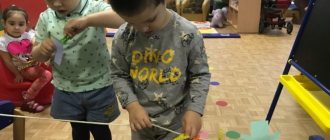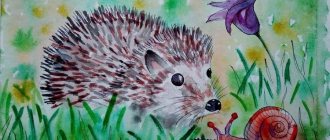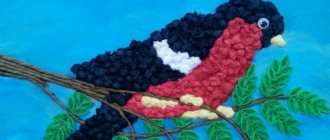What is rhythm
Rhythmics is the performance of simple dance movements to music. Rhythmic classes are considered the child’s first conscious steps in dancing. Children become familiar with such concepts as “fast” and “slow”, “loud” and “quiet”, “fun” and “sad”, and learn to move to musical accompaniment. Unlike other musical and physical activities, rhythmics does not focus on technique or physical development of the child. The main emphasis is on the development of coordination, the ability to hear music and perceive rhythm (alternating sounds and pauses).
When planning rhythm classes, it is important to take into account the age characteristics of children.
Children 3-4 years old have poorly developed coordination, they have poor body control and do not understand how to connect their movements with music. The main task of the music director is to help the child develop coordination of movements.
By the age of five, a child can already coordinate not only his own actions, but also work in pairs. He has a good imagination and can repeat a combination of several movements at a time.
At the age of 7, the child already has full control of his body. He can express emotions and feelings through movements, control the quality of performance, and come up with his own movements and combinations.
It is important for the teacher to select exercises for classes in such a way that they correspond to the age of the students.
How to tell about notes?
Before you introduce your child to notes, you need to explain to him what they are.
Notes are recorded sounds. Just as we write our speech in letters, so music is written in notes. There are a huge variety of notes: both high and low, but they are all divided into 7 basic ones, which everyone knows: do, re, mi, fa, salt, la, si.
The notes live on a musical staff, which consists of 5 lines. The notes can be located either directly on these lines, or between them, they can also be under and above the lines, and on additional lines that we draw above or below.
Draw a staff of music on a large sheet of paper and write notes in a row on it (you can color them in different colors). Then sing them all together with your child.
To make your child interested in learning notes, you can show him a cartoon about the notes “Do Re Mi.”
A start has been made - the child has a general understanding of notes. Only after showing interest in notes can you start learning them seriously (it’s better to do this on another day).
What sounds of nature should I include for my child to listen to?
- Sounds of the rain;
- Storm;
- Surf;
- Sounds of the forest;
- Birdsong;
- Animal voices;
- Sounds of the city.
Musical development is the ability to distinguish and understand different sounds surrounding a child, the ability to feel the beauty of the surrounding world. In addition to classical works and children's songs, sometimes include sounds from different parts of the world and natural phenomena. While listening to a certain sound, explain what the baby hears and who or what makes that sound.
A selection of rhythmic exercises for children 3-4 years old
Select exercises for rhythmic classes in such a way that children enjoy doing them and at the same time receive tangible benefits - they develop coordination of movements and a sense of rhythm.
Rhythmic echo
Goal: to teach children to hear the rhythm of music.
Children stand in a circle. A short excerpt of a simple piece of music begins to sound, for example, “Chickens” or “Two Cheerful Geese.” The children's task is to exactly repeat the rhythm of the music by clapping their hands. If children have mastered a simple melody, you can increase the duration of the musical segment.
Faster-slower
Goal: to teach children to respond to the rhythm of music and quickly switch from one rhythm to another, to develop attention and improve walking and running skills.
Children stand in a circle and begin to step one after another with their left foot to the beat of the music. As soon as the melody speeds up, the children start running. During the exercise, you can change the speed of the songs several times. For musical accompaniment, we recommend using the melodies “Polka” and “About the Siskin”.
Soldier's March
Goal: to develop a sense of tact in children.
Children stand in a line one after another and choose a “commander”. The teacher plays the song “Soldier's March”. The children’s task is to sit down and stand up for each new musical phrase, and bend over and stand up for the next phrase. And so several times in a row.
Freeze
Goal: to teach a child to express his feelings and emotions through dance.
Children move freely around the hall to the music and dance freely. As soon as the music stops, they should freeze in place in the position they were in. The teacher talks to the kids about why they stopped in this particular position and what it means from an emotional point of view. Then another melody starts playing and the exercise is repeated.
The wind blows
Goal: relax after the active part of the lesson and restore breathing.
Children stand in a circle, the teacher turns on a slow lullaby and says: “We will blow far, we will blow close.”
When hearing the words “we will blow far away,” the children begin to blow very, very hard, but when they say “we will blow close,” on the contrary, they begin to blow weakly and weakly. And so on several times.
Follow the described recommendations when building rhythm classes, and the children will happily run to each lesson. In the next article you will learn about rhythmic exercises for children 5-7 years old.






